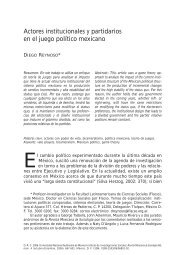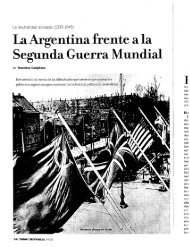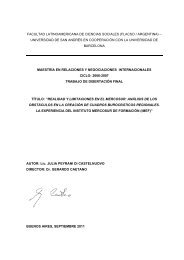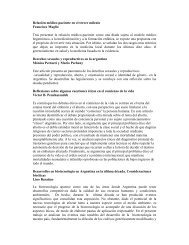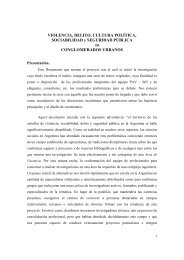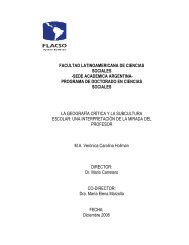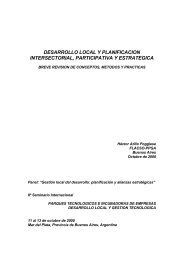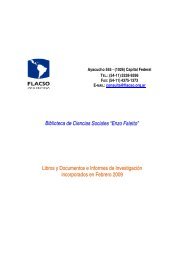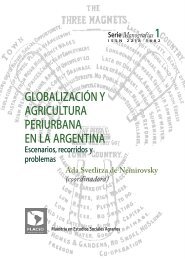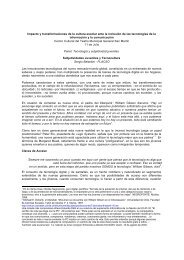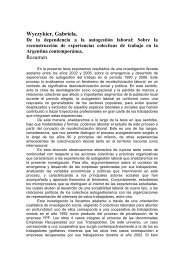Mercedes Botto Andrea Carla Bianculli - Flacso
Mercedes Botto Andrea Carla Bianculli - Flacso
Mercedes Botto Andrea Carla Bianculli - Flacso
You also want an ePaper? Increase the reach of your titles
YUMPU automatically turns print PDFs into web optimized ePapers that Google loves.
the World Bank11. Thus, between 1989 and the beginning of 1991, nominal tariffs were lowered<br />
reaching a level of 10% at the latter date, and the remaining import licenses were eliminated.<br />
Certainly, the arrival of Domingo Cavallo12 at the Ministry of Economy implied the deepening of<br />
the reform process started in 1989, and since then, trade liberalization was pushed even further. By<br />
mid-1991, the average tariff fell to an unprecedented level of 12.2%, an impulse that was partially<br />
reversed in October 1992, when the government established an extraordinary and temporary nontariff<br />
duty of 10% to almost all tariff items. Two years later, this extraordinary levy was reduced to<br />
3%. In addition, the government adopted a series of measures intended to promote exports and<br />
reduce the manufacturing costs: the reduction and elimination of different taxes and the<br />
establishment of credit facilities and measures aimed at stimulating exports.<br />
However, this reduction was not homogeneous across sectors. In fact, it was structured around<br />
groups of tariffs in order to give greater protection to goods locally produced and those used in the<br />
production process vis-à-vis those that were not produced at home together with consumption<br />
goods. Therefore, for instance, in 1992 the tariff structure established 20% for consumption goods,<br />
10% for intermediate products, and 0% for capital and intermediate goods not locally produced,<br />
while the automobile sector and electronic products remained as the two big exceptions to this<br />
scheme with a tariff of 35% [Viguera, 1998: 14].<br />
In terms of the regional integration process that had already been initiated with Brazil, in 1990 the<br />
Act of Buenos Aires implied a key transformation by establishing an approach to trade<br />
liberalization based on an automatic, linear and universal mechanism of tariff elimination. A year<br />
later, the Treaty of Asunción extended these commitments to Paraguay and Uruguay, and created<br />
the Mercosur13. The final aim was to achieve “the free circulation of goods, services and productive factors<br />
among the member countries, through the elimination of the tariff and non tariff restrictions to the circulation of<br />
merchandises and of any other equivalent measure”.<br />
Four mechanisms were included in the founding treaty in order to move towards a common<br />
market: 1. a trade liberalization program, being the final aim the establishment of a zero-tariff state<br />
by December 31st, 1994; 2. the adoption of a CET and a common commercial policy with third<br />
countries or groupings of countries as of January 1st, 1995; 3. the coordination of macroeconomic<br />
and sector policies: foreign trade, agriculture, industry, fiscal, monetary, foreign exchange, capitals,<br />
11 Unilateral trade liberalization was one of the requirements and conditionalities imposed by the IMF and the<br />
World Bank, especially in terms of the elimination of administrative restrictions and especial regimes.<br />
Nevertheless, the tariff reduction would be even larger than that proposed by these institutions; for example,<br />
the World Bank only suggested an average tariff of 25% and a maximum tariff of 40%.<br />
12 Based on the Fundación Mediterránea think-tank, Domingo Cavallo was Minister of Foreign Affairs<br />
between 1989 and 1991, and was then instrumental in the realignment of Argentina with the United States.<br />
13 During the 1990s, Argentina became increasingly interested in regional agreements, which include not only<br />
Mercosur, but other initiatives such as the trade negotiations under the Free Trade Area of the Americas<br />
(FTAA), and those aimed at establishing an agreement between Mercosur and the European Union (UE), on<br />
one hand, and with the Andean Community, on the other. Nevertheless, the most important initiative was the<br />
formation of the Mercosur together with Brazil, Paraguay and Uruguay.<br />
14



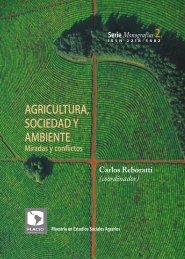
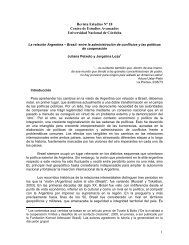
![[P] Disertacion.Melisa.Galvano.pdf - Flacso](https://img.yumpu.com/14596629/1/184x260/p-disertacionmelisagalvanopdf-flacso.jpg?quality=85)
